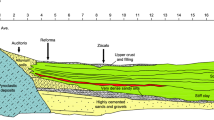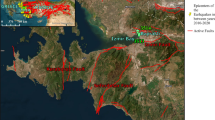Abstract
During the October 30, 2020 Mw7.0 Samos Earthquake, the Turkiye-Izmir-Bayrakli district was affected the most due to the geometry and the deep-soft alluvial nature of the basin, although the district is approximately 70 km away from the epicenter. In this study, the seismic response of the Bayrakli basin, and the role of the soil stratigraphy and basin geometry on the recorded amplifications and prolonging of seismic shakings are investigated by using 1-, 2- and 3-D non-linear finite element-based dynamic response analyses. The assessment results are presented in the form of spectral amplification ratios, \(A\left(T\right)\). The highest \(A(T)\) values were estimated at spectral periods T = 0.85 and 1 s. They exceed five in both the east–west and the north–south directions, more pronounced in the latter one. \(A\left(T\right)\) was decomposed into the product of two independent amplification factors, namely rock to soil amplifications, \({A}_{Soil}(T)\), and 1-D soil column to 3-D soil basin amplifications, \({A}_{Basin}(T)\). \({A}_{Basin}(T)\) values for T = 0.85 and 1 s are estimated as high as 1.4 and 1.6, in the east–west and the north–south directions, respectively. These values suggest that the 3-D geometry of the Bayrakli basin amplifies the spectral accelerations by 40–60% at T = 0.85 and 1 s. The unique combination of a deep-soft alluvial site with 3-D basin geometry, and overlying 7–9 story residential buildings, consistently favors and amplifies the seismic energy in the spectral period range of 0.7–1.0 s. This multi-fold increased seismic demand, combined with poor structural design and construction details, lead to localized structural damage and over 117 life losses.

















Similar content being viewed by others
Data availability
All data and models analyzed during the current study are available from the corresponding author on reasonable request.
References
Akgun A (2012) A comparison of landslide susceptibility maps produced by logistic regression, multi-criteria decision, and likelihood ratio methods: a case study at Izmir, Turkey. Landslides 9:93–106
Akgun M, Ozyalin S, Pamukcu O, Gonenc T, Ersay EY (2011) The geophysical methods applied in alluvial basin (A case study in Izmir). Int Multidiscip Sci Geoconf EXPO Mod Manag Mine Prod Geol Environ Prot SGEM 2:165–172
Amorosi A, Boldini D, Elia G (2010) Parametric study on seismic ground response by finite element modelling. Comput Geotech 37:515–528
Cetin KO, Papadimitriou AG, Altun S, Pelekis P, Unutmaz B, Rovithis E et al (2021) The role of site effects on elevated seismic demands and corollary structural damage during the October 30, 2020, M70 Samos Island (Agean Sea) Earthquake. Bull Earthq Eng. https://doi.org/10.1007/s10518-021-01265-z
Cetin KO, Altun S, Askan A, Akgün M, Sezer A, Kıncal C et al (2022) The site effects in Izmir Bay of october 30 2020, M7.0 Samos earthquake. Soil Dyn Earthq Eng 152:107051. https://doi.org/10.1016/j.soildyn.2021.10705
Cetin KO, Mylonakis G, Stewart JP (2020) Seismological and engineering effects of the M 7.0 Samos Island (Aegean Sea) Earthquake. Geotechnical Extreme Events Reconnaissance Association: Report GEER-069.
Cetin KO, Cakir E, Zarzour M (2023) Historical and futuristic perspectives on seismic site effects in Turkiye-Izmir-Bayrakli basin. Submitted to Bull Earthq Eng.
Hashash YMA, Musgrove MI, Harmon JA, Ilhan O, Xing G, Numanoglu O (2020) DEEPSOIL V7.0, User manual. Board of Trustees of University of Illinois at Urbana-Champaign, Urbana
Joyner WB, Chen ATF (1975) Calculation of nonlinear ground response in earthquakes. Bull Seismol Soc Am 65:1315–1336
Kincal C, Akgun A, Koca MY (2009) Landslide susceptibility assessment in the Izmir (West Anatolia, Turkey) city center and its near vicinity by the logistic regression method. Environ Earth Sci 59:745–756
Kiratzi A, Papazachos C, Özacar A, Pinar A, Kkallas C, Sopaci E (2021) Characteristics of the 2020 Samos earthquake (Aegean Sea) using seismic data. Bull Earthq Eng. https://doi.org/10.1007/s10518-021-01239-1
Kuhlemeyer RL, Lysmer J (1973) Finite element method accuracy for wave propagation problems. J Soil Mech Found Div 99(5):421–427
METU EERC (2020) The October 30, 2020 Izmir-Seferihisar Offshore (Samos) Earthquake (Mw=6.6) Reconnaissance observations and findings. Middle East Technical University Earthquake Engineering Research Center, Ankara
Ozdag OC, Gonenc T, Akgun M (2015) Dynamic amplification factor concept of soil layers: a case study in İzmir (Western Anatolia). Arab J Geosci 8:10093–10104
Pamuk E, Akgun M, Ozdag OC, Gonenc T (2017) 2D soil and engineering-seismic bedrock modeling of eastern part of Izmir inner bay/Turkey. J Appl Geophys 137:104–117. https://doi.org/10.1016/j.jappgeo.2016.12.016
Pamuk E, Özdağ ÖC, Akgün M (2018a) Soil characterization of Bornova Plain (Izmir, Turkey) and its surroundings using a combined survey of MASW and ReMi methods and Nakamura’s (HVSR) technique. Bull Eng Geol Environ 78:3023–3035. https://doi.org/10.1007/s10064-018-1293-7
Pamuk E, Gonenc T, Ozdag OC, Akgun M (2018b) 3D Bedrock structure of Bornova Plain and its surroundings (İzmir/Western Turkey). Pure Appl Geophys 175:325–340
Plaxis (2021) Plaxis 2D software reference manual
Riga E, Makra K, Pitilakis K (2016) Aggravation factors for seismic response of sedimentary basins: a code-oriented parametric study. Soil Dyn Earthq Eng 91:116–132. https://doi.org/10.1016/j.soildyn.2016.09.048
Rodriguez-Plata R, Ozcebe AG, Smerzini C, Lai CG (2021) Aggravation factors for 2D site effects in sedimentary basins: the case of Norcia, central Italy. Soil Dyn Earthq Eng 149:106854. https://doi.org/10.1016/j.soildyn.2021.106854
Schanz T, Vermeer PA, Bonnier PG (1999) The hardening soil model: formulation and verification. Beyond 2000 in computational geotechnics. In: Ten Years of PLAXIS International. Proceedings of the International Symposium, Amsterdam, March 1999 281–296
Schnabel PB, Seed HB (1973) Accelerations in rock for earthquakes in the western United States. Bull Seismol Soc Am 63(2):501–516
Seed HB and Idriss IM (1970) Soil moduli and damping factors for dynamic response analysis. Report EERC 70-10, Earthquake Engineering Research Center. University of California, Berkeley
Smerzini C, Paolucci R, Stupazzini M (2011) Comparison of 3D, 2D and 1D numerical approaches to predict long period earthquake ground motion in the Gubbio plain, Central Italy. Bull Earthq Eng 9:2007–2029. https://doi.org/10.1007/s10518-011-9289-8
Vucetic M, Dobry R (1991) Effect of soil plasticity on cyclic response. J Geotech Eng 117(1):89–107
Yakut A, Sucuoğlu H, Binici B, Canbay E, Dönmez C, İlki A, Caner A, Celik OC, Ay BÖ (2021) Performance of structures in Izmir after the Samos island earthquake. Bull Earthq Eng. https://doi.org/10.1007/s10518-021-01226-6
Funding
The authors declare that no funds, grants, or other support were received during the preparation of this manuscript.
Author information
Authors and Affiliations
Corresponding author
Ethics declarations
Competing interests
The authors have no relevant financial or non-financial interests to disclose.
Additional information
Publisher's Note
Springer Nature remains neutral with regard to jurisdictional claims in published maps and institutional affiliations.
Supplementary Information
Below is the link to the electronic supplementary material.
Rights and permissions
Springer Nature or its licensor (e.g. a society or other partner) holds exclusive rights to this article under a publishing agreement with the author(s) or other rightsholder(s); author self-archiving of the accepted manuscript version of this article is solely governed by the terms of such publishing agreement and applicable law.
About this article
Cite this article
Cetin, K.O., Zarzour, M., Cakir, E. et al. 2-D and 3-D basin site effects in Izmir-Bayrakli during the October 30, 2020 Mw7.0 Samos earthquake. Bull Earthquake Eng 21, 5419–5442 (2023). https://doi.org/10.1007/s10518-023-01738-3
Received:
Accepted:
Published:
Issue Date:
DOI: https://doi.org/10.1007/s10518-023-01738-3




